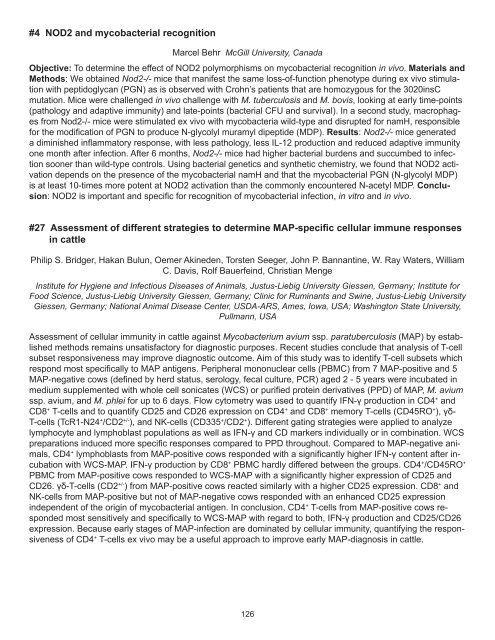Proceedings of the 10th International Colloquium on Paratuberculosis
Proceedings of the 10th International Colloquium on Paratuberculosis
Proceedings of the 10th International Colloquium on Paratuberculosis
Create successful ePaper yourself
Turn your PDF publications into a flip-book with our unique Google optimized e-Paper software.
#4 NOD2 and mycobacterial recogniti<strong>on</strong><br />
Marcel Behr McGill University, Canada<br />
Objective: To determine <str<strong>on</strong>g>the</str<strong>on</strong>g> effect <str<strong>on</strong>g>of</str<strong>on</strong>g> NOD2 polymorphisms <strong>on</strong> mycobacterial recogniti<strong>on</strong> in vivo. Materials and<br />
Methods: We obtained Nod2-/- mice that manifest <str<strong>on</strong>g>the</str<strong>on</strong>g> same loss-<str<strong>on</strong>g>of</str<strong>on</strong>g>-functi<strong>on</strong> phenotype during ex vivo stimulati<strong>on</strong><br />
with peptidoglycan (PGN) as is observed with Crohn’s patients that are homozygous for <str<strong>on</strong>g>the</str<strong>on</strong>g> 3020insC<br />
mutati<strong>on</strong>. Mice were challenged in vivo challenge with M. tuberculosis and M. bovis, looking at early time-points<br />
(pathology and adaptive immunity) and late-points (bacterial CFU and survival). In a sec<strong>on</strong>d study, macrophages<br />
from Nod2-/- mice were stimulated ex vivo with mycobacteria wild-type and disrupted for namH, resp<strong>on</strong>sible<br />
for <str<strong>on</strong>g>the</str<strong>on</strong>g> modificati<strong>on</strong> <str<strong>on</strong>g>of</str<strong>on</strong>g> PGN to produce N-glycolyl muramyl dipeptide (MDP). Results: Nod2-/- mice generated<br />
a diminished inflammatory resp<strong>on</strong>se, with less pathology, less IL-12 producti<strong>on</strong> and reduced adaptive immunity<br />
<strong>on</strong>e m<strong>on</strong>th after infecti<strong>on</strong>. After 6 m<strong>on</strong>ths, Nod2-/- mice had higher bacterial burdens and succumbed to infecti<strong>on</strong><br />
so<strong>on</strong>er than wild-type c<strong>on</strong>trols. Using bacterial genetics and syn<str<strong>on</strong>g>the</str<strong>on</strong>g>tic chemistry, we found that NOD2 activati<strong>on</strong><br />
depends <strong>on</strong> <str<strong>on</strong>g>the</str<strong>on</strong>g> presence <str<strong>on</strong>g>of</str<strong>on</strong>g> <str<strong>on</strong>g>the</str<strong>on</strong>g> mycobacterial namH and that <str<strong>on</strong>g>the</str<strong>on</strong>g> mycobacterial PGN (N-glycolyl MDP)<br />
is at least 10-times more potent at NOD2 activati<strong>on</strong> than <str<strong>on</strong>g>the</str<strong>on</strong>g> comm<strong>on</strong>ly encountered N-acetyl MDP. C<strong>on</strong>clusi<strong>on</strong>:<br />
NOD2 is important and specific for recogniti<strong>on</strong> <str<strong>on</strong>g>of</str<strong>on</strong>g> mycobacterial infecti<strong>on</strong>, in vitro and in vivo.<br />
#27 Assessment <str<strong>on</strong>g>of</str<strong>on</strong>g> different strategies to determine MAP-specific cellular immune resp<strong>on</strong>ses<br />
in cattle<br />
Philip S. Bridger, Hakan Bulun, Oemer Akineden, Torsten Seeger, John P. Bannantine, W. Ray Waters, William<br />
C. Davis, Rolf Bauerfeind, Christian Menge<br />
Institute for Hygiene and Infectious Diseases <str<strong>on</strong>g>of</str<strong>on</strong>g> Animals, Justus-Liebig University Giessen, Germany; Institute for<br />
Food Science, Justus-Liebig University Giessen, Germany; Clinic for Ruminants and Swine, Justus-Liebig University<br />
Giessen, Germany; Nati<strong>on</strong>al Animal Disease Center, USDA-ARS, Ames, Iowa, USA; Washingt<strong>on</strong> State University,<br />
Pullmann, USA<br />
Assessment <str<strong>on</strong>g>of</str<strong>on</strong>g> cellular immunity in cattle against Mycobacterium avium ssp. paratuberculosis (MAP) by established<br />
methods remains unsatisfactory for diagnostic purposes. Recent studies c<strong>on</strong>clude that analysis <str<strong>on</strong>g>of</str<strong>on</strong>g> T-cell<br />
subset resp<strong>on</strong>siveness may improve diagnostic outcome. Aim <str<strong>on</strong>g>of</str<strong>on</strong>g> this study was to identify T-cell subsets which<br />
resp<strong>on</strong>d most specifically to MAP antigens. Peripheral m<strong>on</strong><strong>on</strong>uclear cells (PBMC) from 7 MAP-positive and 5<br />
MAP-negative cows (defined by herd status, serology, fecal culture, PCR) aged 2 - 5 years were incubated in<br />
medium supplemented with whole cell s<strong>on</strong>icates (WCS) or purified protein derivatives (PPD) <str<strong>on</strong>g>of</str<strong>on</strong>g> MAP, M. avium<br />
ssp. avium, and M. phlei for up to 6 days. Flow cytometry was used to quantify IFN-γ producti<strong>on</strong> in CD4 + and<br />
CD8 + T-cells and to quantify CD25 and CD26 expressi<strong>on</strong> <strong>on</strong> CD4 + and CD8 + memory T-cells (CD45RO + ), γδ-<br />
T-cells (TcR1-N24 + /CD2 +/- ), and NK-cells (CD335 + /CD2 + ). Different gating strategies were applied to analyze<br />
lymphocyte and lymphoblast populati<strong>on</strong>s as well as IFN-γ and CD markers individually or in combinati<strong>on</strong>. WCS<br />
preparati<strong>on</strong>s induced more specific resp<strong>on</strong>ses compared to PPD throughout. Compared to MAP-negative animals,<br />
CD4 + lymphoblasts from MAP-positive cows resp<strong>on</strong>ded with a significantly higher IFN-γ c<strong>on</strong>tent after incubati<strong>on</strong><br />
with WCS-MAP. IFN-γ producti<strong>on</strong> by CD8 + PBMC hardly differed between <str<strong>on</strong>g>the</str<strong>on</strong>g> groups. CD4 + /CD45RO +<br />
PBMC from MAP-positive cows resp<strong>on</strong>ded to WCS-MAP with a significantly higher expressi<strong>on</strong> <str<strong>on</strong>g>of</str<strong>on</strong>g> CD25 and<br />
CD26. γδ-T-cells (CD2 +/- ) from MAP-positive cows reacted similarly with a higher CD25 expressi<strong>on</strong>. CD8 + and<br />
NK-cells from MAP-positive but not <str<strong>on</strong>g>of</str<strong>on</strong>g> MAP-negative cows resp<strong>on</strong>ded with an enhanced CD25 expressi<strong>on</strong><br />
independent <str<strong>on</strong>g>of</str<strong>on</strong>g> <str<strong>on</strong>g>the</str<strong>on</strong>g> origin <str<strong>on</strong>g>of</str<strong>on</strong>g> mycobacterial antigen. In c<strong>on</strong>clusi<strong>on</strong>, CD4 + T-cells from MAP-positive cows resp<strong>on</strong>ded<br />
most sensitively and specifically to WCS-MAP with regard to both, IFN-γ producti<strong>on</strong> and CD25/CD26<br />
expressi<strong>on</strong>. Because early stages <str<strong>on</strong>g>of</str<strong>on</strong>g> MAP-infecti<strong>on</strong> are dominated by cellular immunity, quantifying <str<strong>on</strong>g>the</str<strong>on</strong>g> resp<strong>on</strong>siveness<br />
<str<strong>on</strong>g>of</str<strong>on</strong>g> CD4 + T-cells ex vivo may be a useful approach to improve early MAP-diagnosis in cattle.<br />
126






